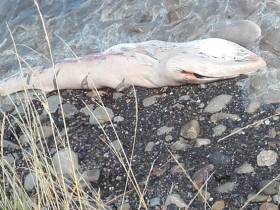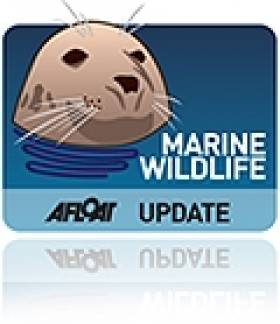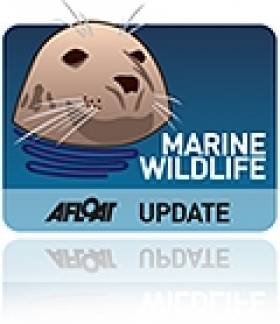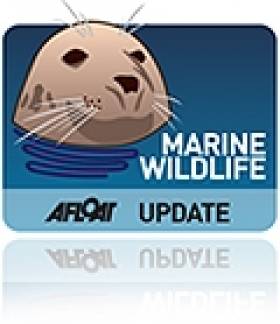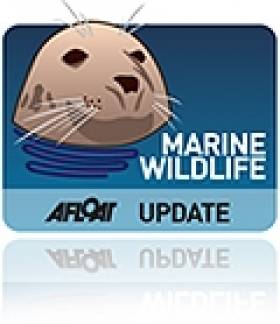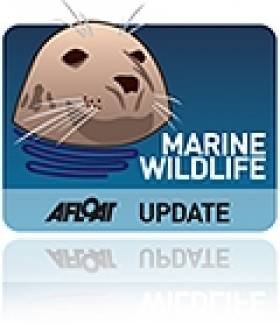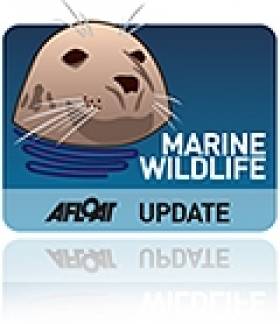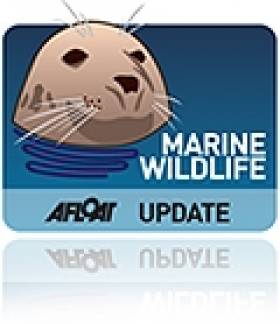Displaying items by tag: minke whale
Public Warned Away From Killiney Minke Whale Carcass
#MarineWildlife - Dun Laoghaire-Rathdown County Council has warned the public to stay away from the carcass of a minke whale that has washed up on Killiney Beach.
According to TheJournal.ie, the carcass of the 13m female minke whale was seen floating off Greystones yesterday and Shankill earlier today (Friday 19 August).
In what's an unusual occurrence for the East Coast, the carcass has washed up on a rocky stretch made even more treacherous by high spring tides – and it may also pose a risk of infection to curious beachgoers.
#dlrcc is aware of deceased 13m minke whale at #Killiney beach. Public asked to avoid location until further notice. pic.twitter.com/9Bvw6kQQhS
— dlrcc (@dlrcc) August 19, 2016
Aerial Whale Survey off Kerry Coast, Seagrass at Courtmacsheery
It seems to me that, without dedicated volunteers, there would be a lot of work not done in the marine sphere, so I like when possible, to highlight what dedicated people are doing. Publicity can help them to raise funding they need by drawing public attention to what they ae doing and achieving support. So in the current edition of THIS ISLAND NATION, the Whale and Dolphin Group takes us on an aerial survey over the Kerry coast as they survey whales in Irish waters.

Minke Whale Pictured Off Seven Heads Photo by Oisin Macsweeney
Years ago we would never have thought that whales would be seen off Ireland, but it has happened and this Summer when sailing along the West Cork coastline off the Seven Heads two minke whales came within a few hundred yards of my Sigma 33, Scribbler II. My 11-year-old grandson, Oisin, was quickest to fetch a camera from the saloon and get a picture. The excitement of seeing whales so close was huge for him, his younger brother of 9 years, Rowan, even their experienced seafarer father, Cormac and myself. The sight of whales, which followed on dolphins playing around the boat for a while, was a reminder of how the sea has many aspects and that protecting it and its inhabitants is a responsibility on all of us. Later in the week’s cruise, for which we were blessed with one of the best weeks of the season, the sight of plastic debris floating along and sea grass despoiling the lovely village environs of Courtmacsherry, was another reminder – of how humans are damaging the marine environment.
Also in the programme this week we hear about the plans by Waterways Ireland for the years ahead and the valuable marine reserve asset which Bull Island in Dublin Bay is for the capital city. What is impressive about what is happening there, in my view, is the joint community and public authority efforts to protect it, about which Dublin Council tells us, outlining what combined, joint effort at this level through communities can achieve.
And I hope you’ll get a smile from the tale which Valentia Island native, Dick Robinson, tells us about going to school every day to the mainland, journeying across the bay on the island ferries and how there was learning, not only at school but also aboard and what it taught youngsters about the benefits, believe it or not, of storms hitting the island.
“We were invited into schools in the North Wall and while all the children had grandparents who were dockers, not one of them knew what a docker was, because all of that tradition is gone….”
Amidst the current controversy over where Dublin Port and Dun Laoghaire Harbour will dump what they intend to dredge up in their plans to provide deeper access channels for the larger cruise ships which they both covet and which business they are fighting for, that comment, made to me on the edge of Dublin Bay by a man dedicated to preserving the maritime traditions of the port, should give cause for thought about where all the commercial development has taken the communities which once bounded in Dublin Port and lived from the jobs it provided.
Alan Martin of the Dublin Dock Workers’ Preservation Society was speaking to me, as we sat on the edge of Dublin Bay, for the current edition of my maritime programme, THIS ISLAND NATION. We could hear the sound of seagulls wheeling in the sky, the rumble of noise emanating from the docks, ships passed in and out, as we talked and he had a reality check for me. He told me that 40,000 jobs have gone from the capital’s port since the time when dock labour sustained viable communities.
“Why do the people of Dublin seem to know so little about the place of the docks in the history of Liffeyside and how their role was once the heart-and-soul of Dublin Port, its shipping and its commerce?”
There are many voluntary organisations doing great work in the marine sphere, without whom much of the maritime culture, history and tradition would be lost. The Dublin Port and Dock Workers’ Preservation Society, set up to preserve the history of Dublin Port, is definitely one such. The interview Alan Martin gave me is revealing. They have encountered many obstacles in their self-imposed task.
He surprised me with his revelations about the extent of the maritime-associated jobs that have been lost and the port-side communities which have suffered in the drive towards modernity. He made strong points about how Dublin’s marine traditions can be preserved and turned into a modern, vibrant, beneficial culture for the benefit of the city.
This offers a bridge from the past to the future, effectively a conveyance of pride in past experience to benefit modern life. Other port communities could, with benefit, replicate the commitment of the Dublin Dock Workers’ Preservation Society.
It was an interview I enjoyed doing and I think you will enjoy listening to. I am fortunate to work as a marine journalist and to meet exceptional people in the ports and maritime communities. So it is good to report in this programme, a positive attitude amongst young people in coastal areas, many of whom are joining the lifeboat service. Also featured in this edition of the programme is the delight of a coastal town when it gets a new lifeboat, as I found in Youghal in East Cork.
And there is always something interesting and unusual about the sea to report, such as the 467 million years old sea scorpion found in a river in Iowa in the USA.
Listen to the programme by clicking at the top of the page
Minke Whale Calf Beaches On Lough Foyle Shore
#MarineWildlife - A minke whale calf has died after beaching on the shore of Lough Foyle near Limavady last week, as BBC News reports.
The whale, thought to be just three months old, was first spotted by locals washed up on the beach in Myroe on Friday 29 May and was encouraged back into the sea, but was later found deceased in an emaciated condition on Tuesday 2 June.
"We assessed the situation and noted that the animal was an unweaned calf about three months old and apparently separated from its mother," said a spokesperson for Norther Ireland's Department of Environment, which has since removed the carcass.
"The calf was severely malnourished and had suffered extensive injuries during its several standings."
The spokesperson confirmed that there is no correlation between this stranding and the recent mass stranding of pilot whales off the Isle of Skye in western Scotland.
According to the Irish Examiner, nine were lost from the group of 21 whales that beached at Staffin in the north east of the Inner Hebridean island on Tuesday 2 June.
The incident is the worst since 16 pilot whales died after stranding near St Andrews in September 2012.
Beached Minke Whale Is Furthest Inland Ever Recorded
#MarineWildlife - A minke whale who beached along a river far upstream from Kenmare has been rescued thanks to the timely response of locals.
As RTÉ News reports, it's believed that the whale - found some 3km from the Kerry coastal town along the River Roughty – is the deepest inland such marine wildlife has ever been found in Ireland.
Two local boats guided the lone whale back towards the sea after tireless effort by community volunteers to keep it alive out of the water during low tide.
Dead Minke Whales in Norfolk Follow Derry Stranding
#MarineWildlife - The carcass of a female common minke whale found on a beach in Norfolk on Monday marks the third such discovery on Britain's coasts in a week, as The Guardian reports.
The grim discovery at Sea Palling follows a similar beaching of a larger 7.6m long female minke in nearby Cromer East just four days before.
And as reported on Afloat.ie, a nine-metre minke was found dead on the beach at Magilligan Point in Co Derry last week - itself the third whale standing in Northern Ireland since September.
The Sea Palling whale, believed to have washed up on the beach dead, was found by North Norfolk council staff with a hole in its jaw and abrasions on its body, but according to Sea Watch Foundation was "well-fed and otherwise healthy".
A post-mortem was set to be carried out yesterday (26 November) to determine if the stranding provides any cause for concern for minke whales who come to British and Irish shores in big numbers over the winter months.
Dead Minke Whale, Poorly Turtle Stranded On Irish Beaches
#MarineWildlife - BBC News reports on the sad story of a nine-metre long minke whale found dead on the beach at Magilligan Point in Derry.
According to the Irish Whale and Dolphin Group's (IWDG) Pádraig Whooley, minke whales have been "reported with increased frequency off the Antrim and Down coast" and there have been sightings in he past week off Donegal.
The incident marks the third whale stranding on the Northern Irish coast since September, when two died after beaching in North Antrim.
In more positive marine wildlife news, a loggerhead turtles is being cared for at the Galway Atlantaquarium after stranding in a bad condition in Co Clare during the week.
The Irish Independent reports that the turtle, named Leon after the famous Quilty shipwreck, was recovered after a local woman alerted marine wildlife experts.
“You might see a loggerhead turtle wash up every couple or three years but not very often at all," said Dr Simon Berrow of the IWDG, who said the turtle may need several months' rehab before its fit to return to the wild.
That's an issue that presents its own challenges due to its smaller size and distance from its usual tropical waters.
#MARINE WILDLIFE - Experts at the Irish Whale and Dolphin Group (IWDG) have been puzzled by a rare photo of a minke whale breaching in the Irish Sea, as the Larne Times reports.
Minke whales are a regular visitor to these shores, but are not known to breach in Irish waters.
But RIB skipper Peter Christian has convinced at least one knowledgeable colleague that the eight-metre whale he snapped breaching some eight or nine times while en route from the Isle of Man to Islandmagee is the real McCoy.
Peter Steele of boat owner North Irish Diver Ltd pointed to a distinctive white patch on its pectoral fin as proof.
“It is rare for minke whales to be caught breaching in these waters, as they are normally much more sedate,” he said.
The Larne Times has more on the story HERE.
Happy Outcome for Mayo's Stranded Minke Whale
#MARINE WILDLIFE - Conor McGuire and friends were taken by surprise when they came across a stranded minke whale in Clew Bay, Co Mayo - but thankfully this whale of a tale had a happy outcome.
As the Irish Whale and Dolphin Group (IWDG) reports, the group of friends videoed the scene as the 4-5m young minke whale attempted to free itself from the shingle at the edge of the shore.
The IWDG commented: "Sometimes it is hard to avoid the temptation to jump in and get involved in coaxing the cetacean back into deeper water.
"But hats off to Conor and friends, who quite rightly gave the whale as much time as it needed to correct the situation."
According to the IWDG, such stranding often end in tragedy "as the animal becomes disorientated and stressed, so this record is particularly unusual."
The group also noted "with interest" that the event occurred just before the biggest earthquake ever recorded in the North West region.
As previously reported on Afloat.ie, the epicentre of the magnitude 4 quake was close to the Corrib Gas Field off Co Mayo.
The IWDG said it will be closely watching the region "to see if there is any spike in unusual stranding events that may be linked to this seismic activity".
Rare Stranding of Minke Whale on Achill Island
#MARINE WILDLIFE - A minke whale died shortly after washing ashore in what was a rare stranding on Achill Island last week, according to Mayo News.
The whale, reportedly and eight-metre adult male, was discovered beached on Keel beach last Tuesday 17 April, It was the first recorded stranding of a whale on Achill Island in over 20 years.
It was followed by reports of a second whale stranded on Annagh Strand on the north side of the island, though full details are unclear as the tide returned the animal to the sea.
“We can’t say why the whale came ashore or how it died,” said Orla Calvel of the Irish Whale and Dolphin Group (IWDG). “It was not an old whale, as it was very clean – older whales would have barnacles on them."
The IWDG retrieved a tissue sample from the carcass for DNA purposes to record the stranding.
Kenmare Locals Fail to Save Stranded Whale
Kenmare is no stranger to animal wildlife but rescuers were sadly unable to save an 18ft juvenile minke whale found stranded at Blackwater Pier, near Kenmare, Co Kerry last Friday.
The Irish Independent reports that despite the best efforts of local people and the National Parks and Wildlife Service (NPWS) to refloat the whale, the call was made to put it to sleep.
"It was so long out of the water it was pointless to try to refloat it as its internal organs would have been damaged," said local ranger Michael O'Sullivan.
The tragedy - the latest in an increasing number of strandings in the UK and Ireland - brought out more than 100 local residents to pay their respects at Blackwater Pier, a popular fishing spot.


























